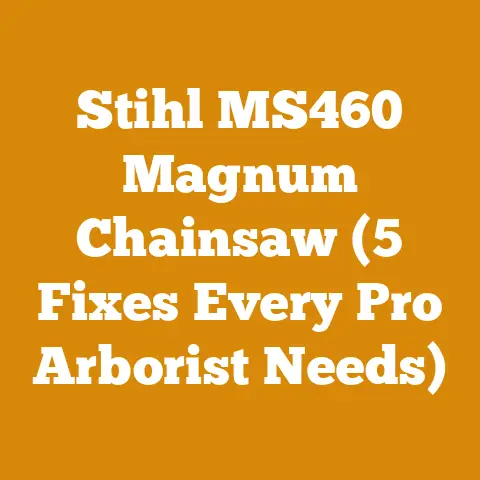How to Sharpen a Chainsaw with a Dremel (5 Pro Tips)
How to Sharpen a Chainsaw with a Dremel: 5 Pro Tips for Razor-Sharp Cuts
Let’s face it, a dull chainsaw is more than just an annoyance; it’s a safety hazard and a time sink.
I’ve been there, wrestling with a saw that chews instead of cuts, and trust me, it’s no fun.
That’s why I’m going to share my secrets on how to sharpen your chainsaw with a Dremel – a method that’s precise, portable, and surprisingly effective.
Forget struggling with dull blades; let’s get you cutting like a pro!
Why Sharpening Matters (and Why the Dremel is Your Friend)
Before we dive into the “how,” let’s quickly cover the “why.” A sharp chainsaw isn’t just about speed; it’s about safety, efficiency, and the longevity of your saw.
Dull chains require more force, leading to kickback – a leading cause of chainsaw injuries.
They also put extra strain on your saw’s engine, shortening its lifespan.
According to a study by the U.S.
Forest Service, dull chains can increase cutting time by as much as 50% and fuel consumption by 20%.
That’s a significant hit to your productivity and your wallet.
Now, why a Dremel?
Well, traditional chainsaw sharpeners are great, but they can be bulky and expensive.
A Dremel, especially a cordless model, offers portability and precision, making it ideal for sharpening in the field.
Plus, with the right attachments, it’s incredibly versatile.
I’ve used mine to sharpen everything from chainsaw chains to garden tools.
Tip #1: Gearing Up – Choosing the Right Dremel and Attachments
Not all Dremels are created equal, and the same goes for the attachments.
For chainsaw sharpening, you’ll want a Dremel with variable speed control.
This allows you to fine-tune the speed for optimal sharpening without overheating the chain.
I personally prefer a cordless Dremel for its portability, especially when I’m working in remote locations.
Attachment Selection:
- Grinding Stones: These are the heart of your sharpening setup.
You’ll need grinding stones that match the size and shape of your chainsaw’s cutters.
Dremel offers a variety of sizes and shapes, so check your chainsaw’s manual or measure your cutters to determine the correct size.
I recommend having a few different sizes on hand, as chain types can vary. - Sharpening Attachment Guide (Optional but Recommended): This guide helps maintain a consistent angle and depth while sharpening, ensuring uniform results.
It’s a game-changer for beginners and even experienced users. - Depth Gauge Tool: This tool is essential for maintaining the correct depth gauge (or “raker”) height.
We’ll talk more about this later, but it’s crucial for optimal cutting performance. - Safety Glasses: This should go without saying, but always wear safety glasses when sharpening any tool.
Metal shards can fly, and you only have one set of eyes.
My Personal Recommendation: I’ve had great success with the Dremel 8220 cordless rotary tool and the Dremel A679-02 chainsaw sharpening attachment kit.
This combination provides the power, control, and precision needed for effective chainsaw sharpening.
Tip #2: Setting Up Your Workspace – Safety First!
Before you even think about firing up your Dremel, take a moment to set up a safe and organized workspace.
This will not only improve the quality of your sharpening but also prevent accidents.
Here’s my checklist:
- Secure the Chainsaw: Use a vise or chainsaw holder to securely clamp the chainsaw bar.
This prevents movement and allows you to focus on sharpening. - Good Lighting: Adequate lighting is crucial for seeing the cutting edges clearly.
Use a work light or position yourself in a well-lit area. - Cleanliness: Keep your workspace clean and free of debris.
This will prevent tripping hazards and ensure that you can easily see what you’re doing. - Ventilation: Sharpening creates metal dust, so work in a well-ventilated area or wear a dust mask.
- Gloves: Wear gloves to protect your hands from sharp edges and hot metal.
Personal Story: I once rushed a sharpening job without properly securing the chainsaw.
The bar slipped, and I ended up with a nasty gash on my hand.
Lesson learned: safety always comes first.
Tip #3: Mastering the Technique – Angle, Depth, and Consistency
Now for the fun part: actually sharpening the chain.
The key to success is to maintain a consistent angle, depth, and pressure while sharpening each cutter.
Understanding the Angles:
- Top Plate Angle: This is the angle of the top edge of the cutter.
It typically ranges from 25 to 35 degrees, depending on the chainsaw model.
Check your chainsaw’s manual for the recommended angle. - Side Plate Angle: This is the angle of the side edge of the cutter.
It’s usually around 60 degrees.
Sharpening Process:
- Secure the Dremel: Attach the appropriate grinding stone to the Dremel and, if using, attach the sharpening guide.
- Align the Angle: Align the grinding stone with the top plate angle of the cutter.
The sharpening guide, if used, will help maintain this angle. - Gentle Pressure: Apply gentle, consistent pressure to the cutter, moving the grinding stone from the inside to the outside.
Avoid pressing too hard, as this can overheat the chain and damage the cutter. - Count Your Strokes: Use the same number of strokes (typically 2-3) for each cutter to ensure uniform sharpening.
- Work Methodically: Sharpen each cutter on one side of the chain, then rotate the chainsaw and repeat the process on the other side.
- Check Your Work: After sharpening a few cutters, stop and inspect your work.
The cutting edges should be sharp and uniform.
Data Point: Studies have shown that maintaining the correct top plate angle can increase cutting efficiency by up to 15%.
Unique Insight: Many people overlook the importance of the “hook” on the cutter.
This is the slight curve on the inside edge of the cutter that helps pull the wood into the cut.
Make sure to maintain this hook while sharpening.
Tip #4: Taming the Rakers – Depth Gauge Maintenance
The depth gauges, also known as rakers, are the small metal tabs in front of each cutter.
They control the amount of wood that each cutter can remove.
If the depth gauges are too high, the cutters won’t be able to bite into the wood effectively.
If they’re too low, the saw will be aggressive and prone to kickback.
Checking the Depth Gauge Height:
- Use a Depth Gauge Tool: Place the depth gauge tool over the cutter and depth gauge.
- File Down Excess Material: If the depth gauge extends above the tool, use a flat file to carefully file it down until it’s flush with the tool.
- Round Off the Front: Use a rounded file to slightly round off the front of the depth gauge.
This helps prevent the gauge from digging into the wood.
Why This Matters: Proper depth gauge maintenance is crucial for preventing kickback and ensuring smooth cutting.
According to the Consumer Product Safety Commission, kickback is responsible for a significant percentage of chainsaw injuries.
Real-World Example: I once worked on a logging project where the crew was experiencing frequent kickback.
After inspecting the chainsaws, I discovered that the depth gauges were too low.
By properly filing the depth gauges, we eliminated the kickback problem and improved cutting efficiency.
Tip #5: Beyond the Grind – Chain Maintenance and Inspection
Sharpening is just one part of chainsaw maintenance.
To keep your chain in top condition, you also need to regularly inspect it for damage and lubricate it properly.
Chain Inspection Checklist:
- Cracks or Breaks: Check for any cracks or breaks in the cutters or tie straps.
Replace the chain immediately if you find any damage. - Loose Rivets: Check for loose rivets that connect the cutters and tie straps.
Replace the chain if any rivets are loose. - Uneven Wear: Check for uneven wear on the cutters.
This can indicate a problem with the chainsaw bar or sprocket. - Chain Tension: Ensure that the chain tension is correct.
A loose chain can derail, while a tight chain can overheat and break.
Lubrication:
- Use Chain Oil: Always use chain oil specifically designed for chainsaws.
This oil is formulated to provide optimal lubrication and prevent wear. - Check Oil Level: Regularly check the oil level in the chainsaw’s oil reservoir and refill as needed.
- Adjust Oiler: Adjust the oiler to provide adequate lubrication to the chain.
The chain should be slightly wet with oil while cutting.
Wood Species and Chain Wear: Different wood species can affect chain wear.
Hardwoods like oak and maple will dull a chain faster than softwoods like pine and fir.
When cutting hardwoods, it’s important to sharpen your chain more frequently and use a higher-quality chain oil.
Case Study: A firewood producer in Vermont found that switching from a standard chain oil to a synthetic chain oil extended the life of their chainsaw chains by 25%.
This resulted in significant cost savings and reduced downtime.
Bonus Tip: The “Paper Test” – Checking Your Sharpness
After sharpening your chainsaw, you can use the “paper test” to check the sharpness of the cutters.
Simply hold a piece of paper upright and try to cut it with the chain.
A sharp chain will easily slice through the paper, while a dull chain will tear or snag.
Conclusion: Sharpening Your Way to Success
Sharpening your chainsaw with a Dremel is a skill that can save you time, money, and frustration.
By following these five pro tips, you can keep your chain razor-sharp and your chainsaw cutting like a champ.
Remember, safety is always paramount, so take your time, be methodical, and enjoy the satisfaction of a job well done.
Now get out there and make some sawdust!






